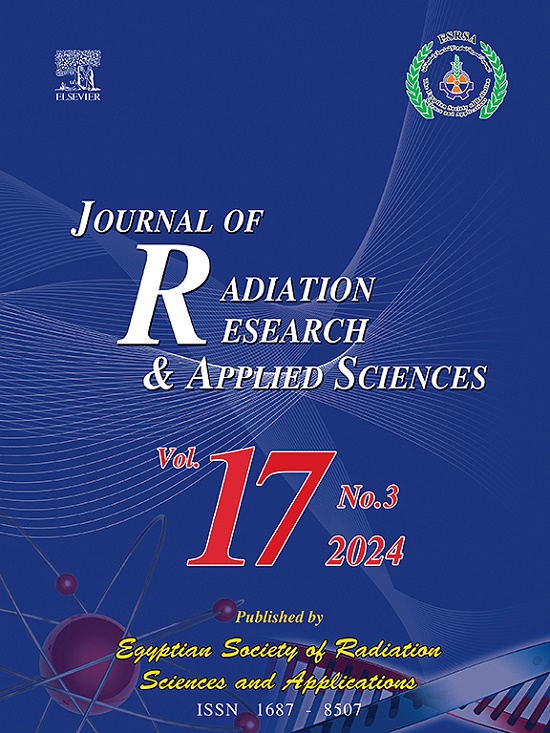Applications of trihybrid nanofluid in industrial cooling systems: An investigation of thermophoresis in chemical reactive flow and thermal radiation
IF 1.7
4区 综合性期刊
Q2 MULTIDISCIPLINARY SCIENCES
Journal of Radiation Research and Applied Sciences
Pub Date : 2025-03-14
DOI:10.1016/j.jrras.2025.101414
引用次数: 0
Abstract
Thermal radiation's effects on the chemical reactive flow of MHD trihybrid nanofluid around a rotating sphere with thermophoresis and porous medium are investigated in this work. Marangoni convection and heat generation analysis are important in this investigation. The suggested model has important uses in a number of technical and industrial domains where thermophoretic particle deposition and thermal radiation are essential. Ethylene glycol-based trihybrid nanofluids improve heat transfer efficiency, making them especially helpful in aeronautical engineering for thermal management systems, nuclear reactor cooling, and electronic device cooling. The model also helps the chemical processing industries by improving combustion and catalytic reactions. Advanced energy systems, such as solar thermal collectors and hybrid energy storage devices, benefit from its understanding of heat and mass transmission mechanisms. A trihybrid nanofluid made up of iron oxide , copper ethylene glycol ( and titanium oxide as the improper liquid is used. Using the bvp4c and a shooting approach, the numerical solution of the reduced equations are determined. Graphical displays are used to demonstrate the numerical outcomes. Investigation is done on the effects of various restrictions on their respective domains. The mass transfer rate and concentration dispersion decrease when the thermophoretic particle deposition parameter and the chemical reaction parameter rise.

三杂化纳米流体在工业冷却系统中的应用:化学反应流和热辐射中的热泳现象研究
研究了热辐射对MHD三杂化纳米流体绕热泳球和多孔介质的化学反应流动的影响。马兰戈尼对流和热生成分析在该研究中很重要。所建议的模型在热泳颗粒沉积和热辐射必不可少的许多技术和工业领域具有重要用途。乙二醇基三杂化纳米流体提高了传热效率,使其在航空工程热管理系统、核反应堆冷却和电子设备冷却方面特别有用。该模型还通过改善燃烧和催化反应来帮助化学加工工业。先进的能源系统,如太阳能集热器和混合储能装置,受益于它对热量和质量传递机制的理解。使用由氧化铁(Fe3O4)、铜(Cu)、乙二醇(C2H6O2)和氧化钛(TiO2)组成的三杂化纳米流体作为不合适的液体。利用bvp4c和射击法,确定了简化方程的数值解。图形显示用于演示数值结果。调查了各种限制对各自领域的影响。随着热泳颗粒沉积参数和化学反应参数的增大,传质速率和浓度分散减小。
本文章由计算机程序翻译,如有差异,请以英文原文为准。
求助全文
约1分钟内获得全文
求助全文
来源期刊

Journal of Radiation Research and Applied Sciences
MULTIDISCIPLINARY SCIENCES-
自引率
5.90%
发文量
130
审稿时长
16 weeks
期刊介绍:
Journal of Radiation Research and Applied Sciences provides a high quality medium for the publication of substantial, original and scientific and technological papers on the development and applications of nuclear, radiation and isotopes in biology, medicine, drugs, biochemistry, microbiology, agriculture, entomology, food technology, chemistry, physics, solid states, engineering, environmental and applied sciences.
 求助内容:
求助内容: 应助结果提醒方式:
应助结果提醒方式:


